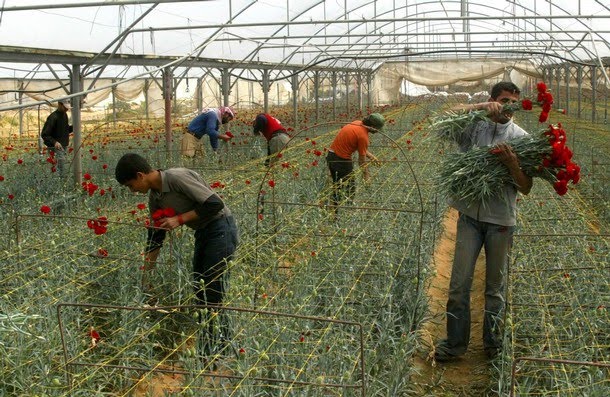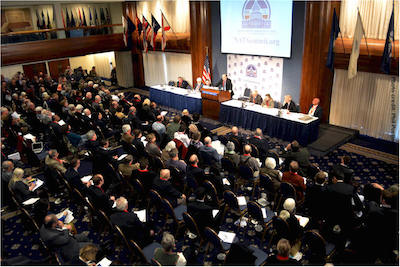Setting the Record Straight: The Greenhouse propaganda—How Gazan history was rewritten to dehumanize Palestinians
May 12 2015 / 8:11 pm
Two months prior to the withdrawal, in July of 2005, Israeli settlers demolished about half of the greenhouses….
By Justin Schweigel –According to the history being written by Clinton and Krauthammer, Ariel Sharon made the decision to pull out of Gaza as a goodwill gesture toward peace and left the greenhouses behind so that Palestinians in Gaza could prosper. Palestinians decided to destroy the greenhouses because, according to Clinton “the leadership said, We don’t want anything left from Israel, [and they] destroyed it all.” Her version, which is by no means the most extreme, implies Palestinians destroyed the greenhouses in a self-destructive, anti-Semitic rage. This version of events is far removed from historical reality.
Why did Israel withdraw from Gaza?
Israel apologists view the 2005 withdrawal from Gaza as an altruistic act. In reality there is not much land nor many natural resources in Gaza, aside from a couple of offshore natural gas reservoirs. Prime Minister Ariel Sharon knew that allowing settlers to remain in the Gaza strip posed a massive “demographic threat,” an Israeli term for the threat that Palestinians might become the majority in Israel thereby making it impossible for Israel to be both Jewish and democratic. There were about 1.5 million Palestinians at the time who would have become Israeli if Israel had tried to swallow Gaza whole. The demographic threat was the reason for the withdrawal, and the reason for Gaza’s being quarantined from the outside world, not the hope that Gaza would become peaceful and prosperous.
What really happened to the greenhouses?
According to the New York Times, two months prior to the withdrawal, in July of 2005, Israeli settlers demolished about half of the greenhouses, “creating significant doubts that the greenhouses could be handed over to the Palestinians as ‘a living business.’” There are other reports that rather than leave their greenhouses behind for the Palestinians some settlers decided to burn them to the ground.
Notwithstanding the destruction that had already been wrought, wealthy American philanthropists led by the Gates foundation and James Wolfensohn, the US Special Envoy for Gaza Disengagement, bought the remaining greenhouses from the Israeli settlers on behalf of the Palestinians in Gaza for $14 million. Wolfensohn contributed $500,000 of his own money.
Admittedly, Palestinian looters took to the greenhouses when they were transferred to Palestinian control in mid-September 2005, hauling away some of the irrigation pipes, water pumps, plastic sheeting and glass, but leaving the greenhouses themselves structurally intact.
Bassil Jabir was the CEO of the Palestine Economic Development Company (PED), the organization founded by the Palestinian Authority to take charge of the greenhouse project after it was turned over to the Palestinians. The PED invested more than $20 million into the project. Jabir said that as a result of the destruction by Israeli settlers and Palestinian looters the PED had to invest an additional $5 million into the greenhouse project to revive it.
Despite the initial setbacks, the greenhouses were up and running by mid-October. By late November, the New York Times reported that the Palestinians were preparing to harvest a crop of peppers, strawberries, tomatoes and herbs worth $20 million. Presciently, in the same article, Palestinians expressed concern that if Israel did not keep the Karni border crossing open, it could result in the demise of the greenhouse project.
In mid-December, the greenhouses made their first export of 8 tons of peppers. Speaking to the Associated Press about the success of the project, Jabir said, “It makes us proud. This land was a symbol of occupation and many people were doubting our ability to rehabilitate [it], but now we have proven that we, as Palestinians, are able to manage our lives, to farm our land and to do our own business.”
That hope and pride soon turned to despair. According to Jabir, in order for the project to be successful, it would require moving at least 25 truckloads of produce a day through the Karni crossing. On rare days when the Karni crossing was functioning smoothly he was only able to move 3 truckloads. A crossing that was supposed to be open 24/7, per an international agreement to which Israel was party, was only open sporadically and unpredictably. Israel cited security concerns. The Palestine Economic Development Corporation and its Israeli distribution partner Adafresh were losing hundreds of thousands of dollars every week.
By February 2006, the BBC reported that because the farmers could not get their produce through the crossing, trucks were dumping perfect, ripe produce onto a wasteland to be eaten by goats. Bassil Jabir joked that because cows were eating their strawberries after they had rotted in the harsh sun next to the checkpoint, they had developed perfectly natural strawberry-flavored milk. According to Special Envoy Wolfensohn, “Instead of hope, the Palestinians saw that they were put back in prison.”
The BBC reported in February 2006, “Palestinians were convinced that Gaza was being deliberately strangled.” In March, Israeli daily Haaretz quoted the Commander of the IDF’s Gaza Division and the head of the Southern Command as stating there was no security-related reason for the closure of the Karni crossing. The Israeli Defense Minister ordered the closures to continue. Speaking to the BBC about Israeli border closures, Mr. Jabir stated, “This is a message to every investor: ‘Don’t come – there’s no hope of any investment flourishing.’” According to a PED report in early March made to Special Envoy Wolfensohn, the closures had cost the greenhouse project $5.4 million in the first two and a half months of 2006.
By April 2006, after months of border closures, there was no money left to pay the agricultural workers, and the project was shut down. Bassil Jabir quit as CEO of the Palestine Economic Development Company in 2006 and left the Gaza Strip in frustration.
During Israel’s June 2006 “Operation Summer Rains,” the United Nations Development Programme estimated that Israel inflicted $23.5 million in damage on Gaza’s agriculture, including damage to the greenhouses. Due to lack of project funds, no crop was planted that fall. During the next harvest season Israel kept the crossings open despite no noticeable change in security threat. Tentative plans were made to lease the greenhouses to independent farmers the next season, but when Israel and Egypt officially began the Gaza siege in 2007, the export-driven project was dead with no hope for revival.
At the beginning of 2008, Hamas militiamen blew a hole in the wall separating Gaza from Egypt. Many Gazans crossed into the Sinai to purchase goods and sell what they could. Farmers who had been prohibited from exporting their agricultural produce for years sold these same greenhouses to Sinai farmers who were not faced with similar export constraints and were happy to have them. Some greenhouses remained. Many were deliberately destroyed by the IDF during operation Cast Lead, which caused nearly $16 million in damage to Gaza greenhouses. Others have been destroyed by the most recent bombardment.
What does the lie accomplish?
The answer to this question depends on context. Hillary Clinton used the lie in a non sequitur to rebut Jon Stewart’s question of why Gazans cannot look to Hamas as their “freedom fighters.” Ezra Levant used it to argue that Palestinians are anti-Semites.
One of the Palestinians’ demands as a condition for a ceasefire during the present conflict is an end to the economically devastating siege and access to a UN-monitored seaport. If pro-Israel pundits admit that Israel killed the Gaza greenhouse project (and the rest of the Gaza economy) through border closures they might also have to admit that this request is reasonable.
The foundation of the lie inevitably denies Israel’s responsibility for destroying a lucrative business while simultaneously implying that Palestinians would rather engage in self-destructive sabotage than build a functioning economy. Indeed, the logic goes, if Palestinians cannot be trusted to keep a profitable greenhouse project running, how could we ever expect them to run a State?
The greenhouses are just one example of an industry choked to death by the Israeli siege. There are hundreds of others.
I caught up with Bassil Jabir this week, and he was not hesitant about what killed the greenhouse project. “All the problems I told you about were problems that we could handle or had handled. If we could have exported our produce we would have made $25 million after recovering our investment. [It was] not what the Israeli settlers did, not what the Palestinian looters did. Yes, it was bad, yes, it was costly, but if we got to export our produce we would have recovered in our first year. The closure [of the Karni crossing] was the evil from which we could not recover…It was my dream project and it was destroyed in front of me.”
The Greenhouse project is dead and with it died the dreams of many Palestinian farmers. Eight years ago the BBC reported on a murder by strangulation. Thanks to American revisionists like Hillary Clinton and Charles Krauthammer, it is now being portrayed as a suicide

